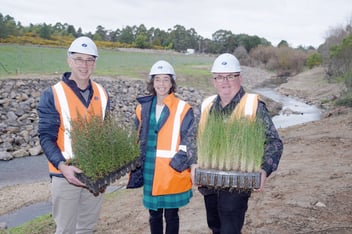Ballarat sewer receives go-ahead for facelift
Originally constructed almost 100 years ago, Ballarat’s two largest sewer lines are in desperate need of an upgrade to ensure ongoing wastewater support is guaranteed for years to come.
As the third-largest city in Victoria, after Melbourne and Geelong, Ballarat’s population is forecast to increase to 210,000 by 2036. With this growth, long-term planning has shown a need for an upgrade to the sewerage system.
Central Highlands Water (CHW) announced the construction of a $25 million upgrade, with construction to commence with Stage 1 in April. The Ballarat Sewer Build will insert an addition six kilometres of sewer pipeline, alongside the current sewer, which is nearing capacity. The sewer line path runs from Brown Hill in the east, through to Ballarat CBD and over to Mount Pleasant in the south.
Stage 1 will cover the CBD to White Flat Oval section, followed by Stage 2 moving from White Flat Oval to Prest Street in Ballarat South. The final stage will cover Peel Street to Brown Hill Reserve in Ballarat East.
Once completed, it’s understood the sewage system will be able to safely collect and remove wastewater for another 100 years.
“This essential community infrastructure project is part of CHW’s regional investment and will cater for the growing demands of Ballarat for another 100 years,” CHW’s Managing Director Paul O’Donohue said, acknowledging the project’s significance.
“It builds on the accomplishment of those before us, who built Ballarat’s first sewerage system — which was the best in the Commonwealth at the time but is nearing its capacity.”
The project is part of CHW’s regional investment, catering for the long-term growth and development of the region.
“Since the original project, Ballarat’s population has grown from 22,000 to 117,000 and although the original works have performed beyond expectations, we are now building to service the next generations,” O’Donohue said.
“At CHW, we see this project as a continuation of this legacy — ensuring we provide long-lasting infrastructure to protect our community and environmental health into the future.”
Michael Dwyer, CHW Project Manager, knows there will be disruption to the community, but calls for understanding as they work to upgrade facilities.
“We understand that there’s going to be some construction impacts," he said.
"We appreciate that at times, we’re going to be taking carparks, at times we’re going to have increased noise. We’ve been out and spoken to all of the traders and we’ll continue to work throughout the project to deliver it in a safe manner, that also considers the impacts to all of the traders and residents in the area.”
The project will also create employment in the local area, including work for a number of contractors who will supply both goods and materials to the project.
O’Donohue stressed that it was important for utilities, such as CHW, to cater for growth, putting the correct infrastructure in place to ensure the community can grow in a sustainable way, with Dwyer echoing the need to work together to ensure the successful completion of the project.
“[This is] a project that considers the past, cares for today and thinks about the future,” he said.
The project is estimated to take five years to complete.


